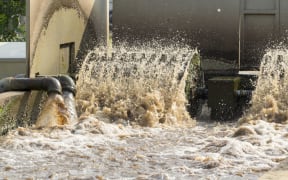
South Beach, Whanganui. Photo: Visit Whanganui
The sea off Whanganui's South Beach has contained so much faecal bacteria at times that it has been eight times above the allowable limit.
Tests of the beach and sea where treated effluent from Whanganui District Council's waste water treatment plant is discharged found high levels of enterococci on three occasions between January and March 2020.
Whanganui District Council then failed to report it had breached its allowable levels to Horizons Regional Council, which is responsible for monitoring what is discharged from the wastewater treatment plant.
The district council, however, is unlikely to face any consequences.
On 6 January, 2020 the council recorded an enterococci count of 830 cfu/100mL at the outfall pipe off South Beach.
Cfu - which stands for 'colony forming units' - is a measure that indicates the level of bacteria in the water.
The council's discharge consent says the count must not exceed 104 cfu/100mL.
Further breaches were recorded on 17 February and 9 March. None coincided with heavy rainfall, which can overwhelm the city's storm water system resulting in untreated sewage being discharged out to sea.
The elevated readings recorded on the three occasions were a "temporary spike" caused by extremely strong offshore winds blowing the treated material back towards the shore, the council said.
The breaches are recorded in the report the council must file each year with Horizons Regional Council, detailing how it complied with its consent.
The latest report, received by Horizons last month, covers the period between 1 July, 2019 and 31 June, 2020.
The report also noted the city's wastewater treatment plant was adversely affected by high levels of chromium unlawfully discharged into the plant by company Tasman Tanning.
Read more:
- Company at top of dumping breach list takes on big new contract
- Revealed: The companies dumping contaminants down the drain
When discharged into the waste water treatment plant, the toxic heavy metal stops good bacteria in the plant from breaking down bad bugs.
This meant effluent containing high levels of faecal material was discharged out to sea.
The report did not say how many times this had happened.
According to its consent, the district council must tell Horizons about any breach within 10 days of it happening.
But the council did not tell Horizons about any of the breaches within this timeframe.
Horizons tests Whanganui's wastewater only once a year, so relies on the district council to monitor the quality of the effluent being discharged itself.
Despite this, the council was "unlikely" to face any penalty, Horizons said in a statement.
"By not notifying Horizons, WDC will be non-complied in the annual compliance assessment report that will be put together in the near future.
"In this instance it is unlikely that further enforcement action will be taken over this singular condition non-compliance, however once the report is completed this and any other non-compliances will be considered. Recommendations will be provided and potential enforcement action may be undertaken as a result," said Horizons Regional Council's team leader consent monitoring Pita Kinaston.
Whanganui District Council chief executive Kym Fell said offshore winds can affect cfu levels on occasion.
"Because it takes two weeks for these tests to be processed, by the time the council receives the results the incident has passed."
"Over the course of the year the median level was required to be below 35 cfu per 100ml and during the reporting period Whanganui District Council's recorded median was a very low 4 cfu per 100 ml," Fell said.
"With the exception of faecal coliform, Whanganui District Council had been compliant with its resource consent," Horizons Regional Council regulatory manager Greg Bevin said
"We are currently in discussions with Whanganui District Council with regards to their faecal coliform readings, which recently show that compliance with this standard has been achieved 74 percent of the time as opposed to the required 90 percent."
*This story originally said faecal bacteria readings were high because raw sewage had been discharged into the sea. This was an error which has now been corrected



